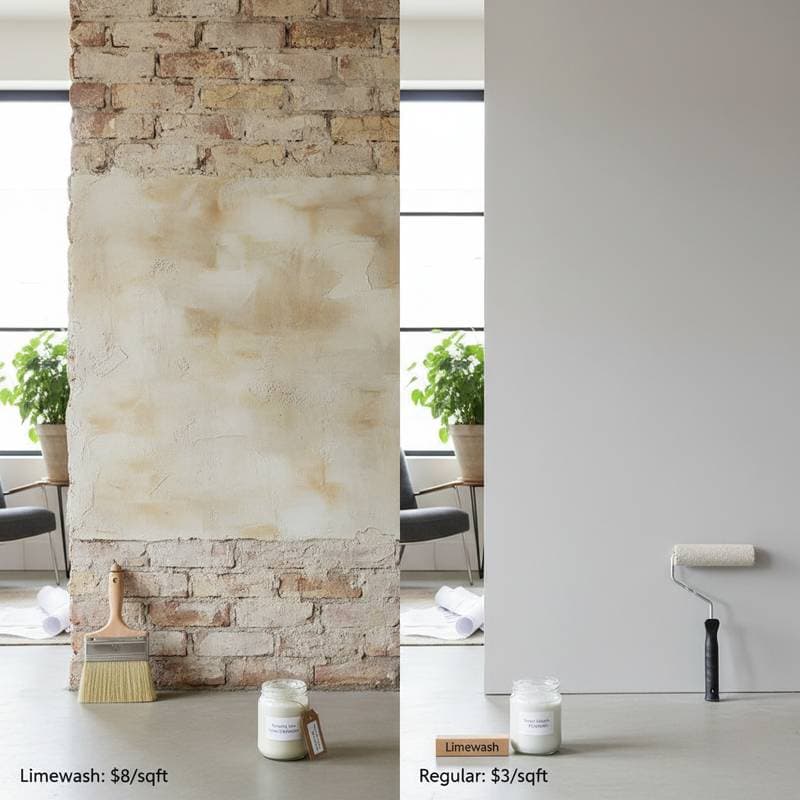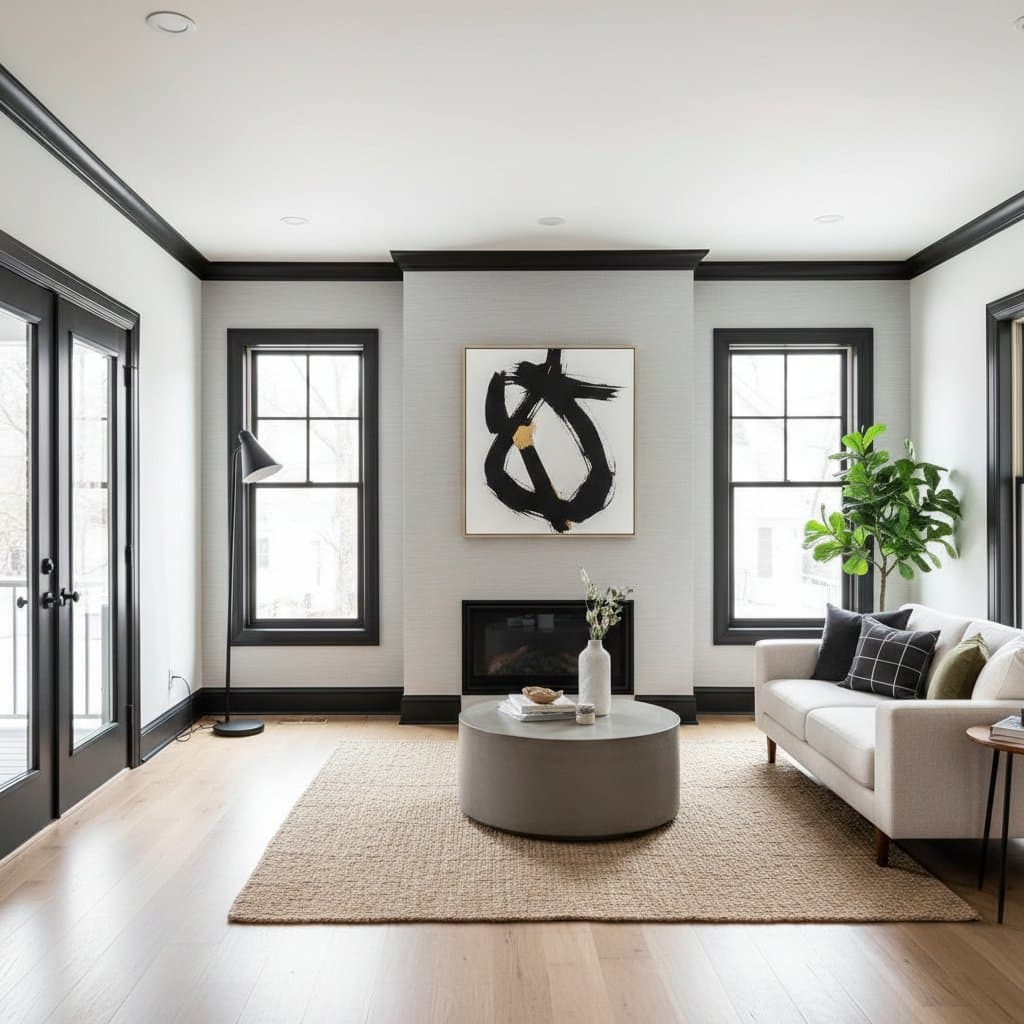Why Limewash Paint Costs $8 per Square Foot Versus $3 for Regular Paint
Homeowners comparing painting options frequently encounter the higher price tag on limewash paint, which exceeds standard acrylic or latex varieties by more than double. This disparity stems from fundamental differences in materials, preparation demands, application methods, and enduring performance. Grasping these elements equips you to decide if limewash aligns with your budget and aesthetic goals.
What Defines Limewash Paint
Limewash derives from slaked lime, or hydrated limestone, blended with water and earth-based pigments. This formula soaks into absorbent substrates like brick, stucco, or plaster, yielding a velvety, uneven patina that evolves during curing. The permeable nature permits vapor transmission, safeguarding against trapped humidity that could foster decay or efflorescence in historic or exterior walls.
In contrast, conventional paints create a film atop the surface, delivering even opacity and sheen. Latex and acrylic formulas adapt to diverse substrates, from drywall to siding, and prioritize affordability through efficient production.
Breaking Down Project Expenses
Typical Pricing Tiers
- Standard regular paint application: $2.50 to $3.50 per square foot
- Routine limewash installation: $6.50 to $8.00 per square foot
- Advanced limewash with bespoke effects: $8.00 to $10.00 per square foot
Core Components of the Quote
- Labor efforts: Thorough cleaning, any necessary priming, and precise layering
- Supply essentials: Base materials, tools like badger-hair brushes, drop cloths, and color enhancers
- Post-work tasks: Debris disposal, quality checks, and subtle adjustments
Potential Add-On Expenses
- Substrate repairs: Fixing cracks or efflorescence in masonry adds $1 to $3 per square foot
- Bespoke coloration: Integrating site-specific pigments boosts costs by 10 to 15 percent
- Durability enhancers: A vapor-permeable sealant increases the total by $0.50 to $1.00 per square foot
Influences on Total Expenditure
| Factor | Impact Level | Specific Instances |
|---|---|---|
| Substrate condition | Substantial | Uneven stone demands extra layers and time |
| Technique used | Medium | Hand-brushing limewash extends labor over spraying regular paint |
| Ingredient purity | Substantial | Organic lime putty outprices petroleum-based binders |
| Artisan proficiency | Substantial | Specialists in historic finishes command elevated fees |
| Scope of work | Variable | Compact areas inflate unit costs from mobilization overhead |
Elements Driving Limewash's Premium Pricing
Natural Formulation Demands
Producing limewash involves quarrying limestone, burning it to quicklime, then slaking and maturing the paste before pigment integration. These steps yield a scarce, artisanal product versus the factory-scale synthesis of polymer emulsions in regular paints. Earth-derived colorants, such as ochres or umbers, further elevate expenses due to their limited availability and nuanced light interaction.
This composition fosters depth in hues that shift with viewing angles and atmospheric changes, a trait synthetic dyes rarely match without added complexity.
Rigorous Application Demands
Standard paints achieve coverage in one or two swift passes with sprayers or rollers. Limewash, however, requires multiple diluted applications, each allowed to carbonate fully for 24 hours or more. The process suits only vapor-open surfaces; non-porous ones demand stripping or etching to ensure uptake.
Pre-application rituals include power-washing masonry and testing pH levels to avoid reactions. These protocols double the hands-on time, directly inflating labor charges.
Expertise in Execution
Mastering limewash calls for apprenticeships in traditional plastering arts, including gauging slurry viscosity and modulating brush pressure for organic distressing. General contractors handle routine coatings with basic training, keeping their rates accessible.
The craft mirrors fresco techniques, where ambient factors like temperature dictate outcomes. Consequently, labor often comprises over 60 percent of limewash budgets, reflecting the precision required for flawless integration.
Enduring Performance Advantages
Limewash matures into a nuanced veil, resisting bio-growth through its high pH environment. This self-regulating quality suits damp-prone settings, minimizing interventions beyond occasional misting.
Traditional paints demand repaints every 5 to 7 years to combat chalking or blistering. Limewash's embedded bonding can extend service life to decades, amortizing the upfront outlay through reduced upkeep.
Sustainability and Visual Appeal
Free of synthetic volatiles, limewash aligns with green building standards, appealing to eco-conscious renovators. Its diffused glow evokes Mediterranean villas, impossible to mimic with glossy enamels.
For sleek contemporary spaces, regular paint's bold saturation and washability hold sway. Limewash thrives where authenticity and permeability take precedence.
Project Scheduling Insights
| Application Category | Overall Timeline | Prep Phase | Coat Intervals |
|---|---|---|---|
| Interior standard paint | 2 to 4 days | 1 day | 4 to 6 hours |
| Exterior standard paint | 3 to 6 days | 1 to 2 days | 6 to 8 hours |
| Interior limewash on plaster | 4 to 7 days | 2 days | 12 to 24 hours |
| Exterior limewash on brick | 5 to 10 days | 3 days | 24 hours |
Anticipate extended timelines for limewash to accommodate carbonation cycles, which avert splotching. Exterior efforts hinge on mild forecasts; avoid rainy spells or intense heat that disrupt curing uniformity.
Deciding Between DIY and Professional Services
Scenarios for Self-Application
Repainting smooth interiors or exteriors suits handy individuals with ladders, masks, and pre-tinted cans. Standard paints tolerate minor errors, allowing sand-and-redo fixes.
Benefits of Expert Involvement
Limewash's finicky chemistry rewards pros who calibrate mixes on-site and layer for seamless gradients. Amateurs risk flaking from over-thick applications or mismatched alkalinity.
Professionals navigate codes for heritage sites and warranty their work against defects, often justifying the fee through superior outcomes.
Selecting Reliable Contractors
Prioritize portfolios over bids when vetting teams for limewash or conventional jobs. Seek evidence of consistent results on similar substrates.
Essential Vetting Practices
- Examine portfolios and testimonials: Review images of aged limewash integrations or request site visits.
- Confirm credentials: Verify state licenses, bonds, and worker compensation.
- Solicit itemized proposals: Detail supplies, manpower allocation, and contingency allowances.
- Test via mockups: Apply a 2-by-2-foot sample to gauge tone and absorption.
- Clarify guarantees: Probe coverage for fading, delamination, or environmental claims.
Preparing for Success
Evaluate your walls' porosity first; limewash bonds best to raw masonry. Sealed or coated areas require abrasion or chemical strippers to restore openness. Consult substrate guides to confirm compatibility and plot phases around seasonal constraints.
Addressing Common Queries
What Accounts for Limewash's Elevated Price Over Standard Paint?
Specialized sourcing of hydrated lime and pigments, coupled with extended curing protocols, drives the premium. Application expertise adds layers of time-intensive detail absent in streamlined regular paint workflows.
How Long Does a Limewash Endeavor Typically Span?
Interior projects wrap in 4 to 7 days, factoring prep and multi-day dries. Exteriors extend to 10 days amid weather variables, contrasting the quicker pace of standard coatings.
Is Self-Applying Limewash a Viable Cost-Saver?
Possible for small tests, yet the precision in ratios and climate control often yields subpar adhesion for novices. Pros deliver uniform patinas that endure, frequently offsetting hire costs via longevity.
How to Weigh Limewash Against Regular Paint?
Opt for limewash on breathable exteriors craving organic texture; choose regulars for vibrant, low-maintenance interiors. Factor aesthetics, substrate, and tolerance for periodic renewal.
What Upkeep Does Limewash Entail?
It weathers gracefully, needing only light reapplication of thinned slurry every 5 to 10 years. Unlike films that crack, it sheds patina naturally without aggressive prep.
What Pitfalls Arise with Limewash, and How to Sidestep Them?
Blotching from rushed coats or residue from excess moisture plague hasty efforts. Engage versed applicators for pH-balanced preps and staged layering to secure even, resilient finishes.
Realizing Lasting Value
Investing in limewash transforms masonry into a living canvas, blending heritage charm with modern resilience. When matched to the right setting, its costs yield dividends in curb appeal and structural health, far outpacing routine repaints.



